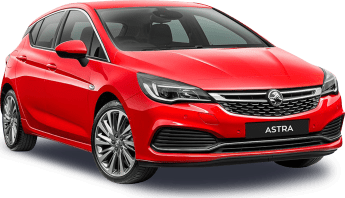The Astra sedan, which is sourced from Korea, joins the Australian small car fray against the likes of the Mazda3 and Toyota Corolla sedan.
It’s a turbulent time at Holden, with the company in the midst of the biggest transition it has ever undergone, exiting local manufacturing this year in favour of importing all its cars.
It’s got no plans to go anywhere, though, and the Holden Astra range is one of the most important in its new-look line-up.
.jpg)
The Astra sedan – which, unlike the German-made hatch, is sourced from Korea - joins the small car fray against the likes of the Mazda3 and Toyota Corolla sedan, and it follows in the wheel tracks of both by offering a car that’s noticeably different to its hatchback sibling.
Holden Astra 2017: LT
| Engine Type | Turbo 4, 1.4L |
|---|---|
| Fuel Type | Unleaded Petrol |
| Fuel Efficiency | 6.1L/100km (combined) |
| Seating | 5 |
| Price From | $10,010 - $13,640 |
| Safety Rating |
|
Is there anything interesting about its design?
8 / 10
More often than not, the sedan version of a brand’s hatchback gets the rough end of the pineapple when it comes to looks, but that’s not the case here at all.
Holden has aimed the Astra at an older, more conservative clientele, and the unfussed, softly played lines of the four-door have resulted in a nicely resolved, understated look that’s easy on the eye.
.jpg)
Chintz and glitter have been kept to a minimum and the rear three-quarter isn’t too bulbous, while strong headlight and tail-light fascias add boldness to the otherwise low-key front and rear visages.
Inside, it’s a similar story of less is more. A restrained palette of blacks and greys manages to avoid the somber zone, while again limiting the use of polished brightwork gives the cabin an air of sophistication. Well played, Holden.
.jpg)
How practical is the space inside?
8 / 10
The Astra belies its external dimensions with a generous amount of interior space for front and back seaters. The longer wheelbase of the sedan over the hatch helps here.
It’s built to take five, but the middle rear seat will be no fun for anyone. The outside rear seats, though, offer excellent knee and headroom for even teenage kids, and two ISOFIX seat mounts are provided along with space for bottles in each door.
.jpg)
There is a single charge point for back seaters, but no vents.
Up front, the seats are comfy, if a little short in base length. The smallish steering wheel is adjustable for height and reach, and even as a tall driver, my back seat passengers weren’t squashed.
.jpg)
Cupholders complement bottle holders, while storage spots are adequate rather than generous.
There’s a note from one of our smaller stature drivers, though, about the height of the brake pedal compared to the throttle when the seat is cinched up close to the steering wheel.
.jpg)
After only a couple of minutes, she found her ankle and shin aching from the effort of flexing her foot back far enough to activate the pedal, resulting in a few choice expletives.
The 445-litre boot is 85 litres bigger than the one in the hatchback – but of course the hatch has the ability to… well, be a hatchback, and utilise the space used by lowered back seats for bigger loads.
.jpg)
Still, the Astra sedan’s cargo space is adequate by small car standards, even though the boot sill is a little high. There’s even a plastic hook for shopping bags.
.jpg)
Oh, and just so you know, a wagon version of the Astra is set to land at the end of the year.

Does it represent good value for the price? What features does it come with?
7 / 10
At $25,790 plus on-road costs, the Astra LT sedan finds itself up against the Honda Civic VTi-S ($24,990), Hyundai’s Elantra Elite ($26,990), the Mazda3 Touring ($25,290), Subaru’s Impreza 2.0i-L ($24,690), and the Toyota Corolla SX sedan at ($23,820 - more like low $25k with an auto).
It’s available with just one engine and gearbox combo; a 1.4-litre turbocharged petrol four-cylinder drives the front wheels via a six-speed automatic transmission.
.jpg)
Standard kit is plentiful, and includes an 8.0-inch touchscreen-based multimedia system (with sat nav, digital radio, plus Apple CarPlay and Android Auto functionality), auto lights and wipers, digital speedo, blind-spot monitoring, park assist, push-button start, leather-clad steering wheel and 17-inch alloys.
.jpg)
It does miss out on AEB, as does the entire sedan line-up, because the Chevrolet Cruze platform on which the Astra sedan is based isn’t built to accept it.
What are the key stats for the engine and transmission?
7 / 10
A 110kW/245Nm 1.4-litre turbo four combines nicely with a proper six-speed automatic transmission to give the sedan a surprisingly eager turn of mid-range pace.
.jpg)
There’s no need to abuse the throttle to make tracks around town, because the gear ratios are sweetly spaced to make the most of the turbo engine’s torque.
Even out on the open road, the 1.4 does a fair job of keeping to the national limit, though it would definitely need to work harder with four people and luggage aboard.
How much fuel does it consume?
7 / 10
Holden claims a combined cycle (urban, extra-urban) fuel economy figure of 6.1L/100km for the Astra sedan, and 220km of mixed terrain saw us record a dash-indicated figure of 7.8L/100km.
With a generous 52-litre tank, the Astra can theoretically travel around 850km on a single fill. It’ll happily take 91RON unleaded and E10, too.
What's it like to drive?
7 / 10
Is the Astra sedan a sports car in drag? Of course not. It is, however, perfectly capable of conducting itself with dignity and competency around town.
Noise intrusion into the cabin, from either the engine or road, is impressively low, while the Astra sedan’s locally tuned suspension delivers a ride notably softer in the initial part of the body's motion than that of the more sporting-focused hatch.
Small low-speed bumps almost disappear under the car, while the ride at mid to high speeds doesn’t deteriorate notably either, unless you’re trying to be a bit silly with it.
The steering feel is light and not especially involving, but we’ve certainly driven worse, and while the high, firm pedal may have divided opinion about comfort, the brakes work well.
While it’s sized like a city car, the Astra will certainly make short work of longer duration trips in relative comfort, especially when driven at civil speeds.
Warranty & Safety Rating
What safety equipment is fitted? What safety rating?
7 / 10
With curtain airbags and an (almost) full complement of driver aids, including lane departure and blind spot warning, forward collision alert and even trailer sway control, the Astra scores a maximum of five ANCAP stars for safety.
As mentioned, AEB can’t be fitted to this generation of car, which means it’s likely to be marked down next year when new ANCAP rules come into force.
What does it cost to own? What warranty is offered?
8 / 10
Holden offers a capped price service program for the entire life of the Astra, with service intervals suggested at 15,000km or 12 months.
Each service up to the 90,000km mark will cost $229. The 120,000km service leaps to $640, but falls back to $529 at 135,000km, and $289 thereafter.
A three-year/unlimited kilometre warranty is provided.
Verdict
Holden is targeting an older, downsizing demographic with the Astra sedan… and this is where it might run into trouble.
The customers it’s looking for are favouring the higher seating positions and easier access of small SUVs, which is partly why the market for small sedans is shrinking at a rapid rate.
Still, as a nimble, frugal, comfortable city car, the Astra sedan does very little wrong out of the box, and it’s certainly a big step up over the Cruze it replaces.
Do small sedans like the Holden Astra appeal to you more than small SUVs? Tell us what you think in the comments below.
Pricing Guides

.jpg)


.jpg)














.png)


.jpg)
.jpg)

.jpg)

